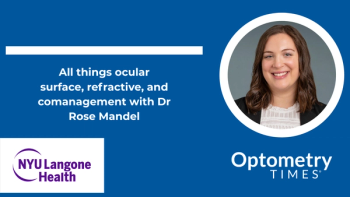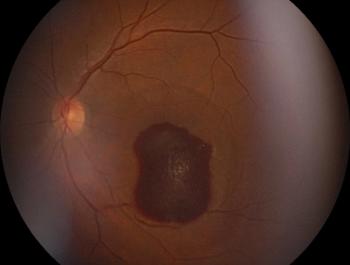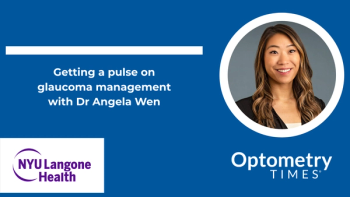
- July digital edition 2023
- Volume 15
- Issue 07
- Pages: 8-9
DED simplified: How to efficiently diagnose, treat, and track dysfunction
Combining simple and advanced methods can lead to optimal patient outcomes.
Although
Here, I will share the DED definition that I follow in a logical approach to care that is neither time-consuming nor expensive, as well as some additional steps for those thinking of expanding their DED care.
A practical scientific definition for DED
Many different definitions of DED exist, but a straightforward definition that Caroline Blackie, OD, PhD, shared with me makes the most sense for my practice.
According to her definition, DED occurs when the ocular surface system fails to protect itself from desiccating stress. I have further broken down DED as a disease of dysfunction, divided into 2 basic types that are easily diagnosed:
1. Meibomian gland dysfunction (MGD): If 6 or fewer meibomian glands in the lower eyelid yield secretions, then the patient has MGD.2 MGD contributes to 86% of DED cases.3
2. Lacrimal functional unit dysfunction: If a patient has decreased tear volume, staining of the cornea or conjunctiva, and/or alteration in the normal tear chemistry (osmolarity, matrix metalloproteinase-9 [MMP-9], other), this indicates lacrimal functional unit dysfunction.
I find that when I have a patient in my chair, this definition gives me a clear, logical framework for approaching DED. Both types of dysfunction can be quickly diagnosed during a routine exam.
Basic and advanced diagnostics
To screen for DED, I start with a validated questionnaire. For my primary screening, I use the Symptom Assessment Questionnaire in Dry Eye (SANDE), which is equivalent in accuracy to the Ocular Surface Disease Index (OSDI)4 and brief and intuitive for patients, using just 2 questions to calculate a DED score. Then I use the Standardized Patient Evaluation of Eye Dryness (SPEED) and/or OSDI to track the progress of my treatment. If the DED score indicates mild, moderate, or severe DED, I can efficiently document the condition and track its improvement.
During the exam, I determine the severity of DED through a simple slit lamp assessment:
1. MGD: We count the number of glands in the lower eyelid that yield secretions as we apply gentle pressure of 1.25 g/mm2 to simulate normal blinking. If 6 or fewer glands are functioning, then the patient has MGD.
2. Lacrimal functional unit dysfunction: To evaluate the 3 factors that indicate lacrimal functional unit dysfunction, we check tear meniscus height or use a Schirmer test to identify decreased tear volume; use lissamine green or fluorescein staining to see disruption of the cellular integrity; and distinguish inflammation through visible signs (redness).
These basic tests are quick, decisive, and offer all the information we need to initiate the appropriate therapies. If you are inclined to invest in other methods, you can evaluate inflammation with an MMP-9 test (InflammaDry; Quidel) and objectively measure tear quality (TearLab Osmolarity
System; Trukera Medical) as another indicator of lacrimal functional unit dysfunction. As a dry eye specialist, I also use a corneal topographer to measure tear meniscus height and tear breakup time (Keratograph 5M; Oculus/Medmont Meridia; Medmont), perform meibography (Keratograph 5M; Oculus/LipiView; Johnson & Johnson Vision/ Medmont Meridia; Medmont), and carry out other advanced tests when indicated.
DED treatment paradigm
DED is defined by dysfunction, so the goal of therapy is to restore function. Symptomatic improvement will follow over time, but our priority is always to restore and preserve function in dealing with this chronic, progressive disease.
All patients
I start all patients on what we call the “dry eye bundle,” adjusted by severity. The bundle includes warm compresses for 5 to 10 minutes (daily or twice a week), omega-3 fatty acids (1000-3000 mg), and daily use of lid scrubs.
Most importantly, proactive management with lubricant eye drops provides the foundation for covering the spectrum of dry eye relief (used in the morning and every few waking hours with the treatment goal of reducing drops over time).
I am specific about the artificial tears I want patients to use because the options are numerous and many contain ingredients that are detrimental for patients with DED. My first choice is iVIZIA (Thea), a tear that offers extended relief for any type of DED and is preservative free, so it is safe for frequent use without causing ocular surface toxicity.
iVIZIA contains povidone and hyaluronic acid (HA), which deliver lubrication with long-lasting relief. Natural HA binds to water for a viscoelastic barrier to friction5 and stimulates healing of the corneal epithelium.4 A third ingredient, trehalose, provides bioprotection, osmoprotection, and rehydration. Trehalose protects and rehydrates the eye6 and has been shown to significantly disrupt DED’s characteristic vicious cycle of inflammation.7,8
At this point—and this is essential—schedule a follow-up appointment in 2 to 4 weeks. The patient will complete the questionnaire again and repeat any tests that yielded abnormal results at the initial visit. My patients typically show improvement after using the dry eye bundle with iVIZIA for this period. If function is not restored, we initiate a second line of treatment. In many cases, practices refer to a specialty dry eye clinic at this point.
MGD
All our patients with MGD have thermal pulsation treatments (iLux; Alcon/LipiFlow; Johnson & Johnson Vision), which clear the thick meibum blocking the glands. In most cases, patients also have clear signs of inflammation, including telangiectasia. In addition to thermal pulsation, these patients receive light-based therapy (OptiLight; Lumenis), which has been shown to improve meibomian glands’ shape and function.9
The treatment also breaks the inflammatory cycle by reducing proinflammatory mediators,9,10 destroying the telangiectasia that release those mediators,11,12 and even shrinking the Demodex population on the eyelids.13 Patients have 4 to 6 treatments of 15 minutes each with OptiLight, spaced 2 to 4 weeks apart. I usually do thermal pulsation at the first or last visit, depending on the patient. The results are exceptional, with thermal pulsation clearing the glands and OptiLight tackling inflammation and providing the kind of functional change patients need for significant, lasting results.
Lacrimal functional unit dysfunction
Tailored therapy is based on the 3 components of this dysfunction. A steroid will quiet acute inflammation in the short term. OptiLight improves inflammation over a longer period. Prescription immunomodulator drops like cyclosporine (Restasis; Allergan) and lifitegrast (Xiidra; Bausch + Lomb) also improve inflammation, as well as reinnervate the lacrimal functional unit to improve tear quality. If staining is present, I use steroids to quiet the reaction and add iVIZIA tears to support healing on the ocular surface.
In more advanced cases, I might place an amniotic membrane or prescribe an amniotic or autologous serum or platelet-rich plasma eye drop. I also tell all patients that they can expect occasional flare-ups, especially if they have seasonal allergies, in which case they should contact me for a short-term steroid.
Routine follow-up visits
The chronic nature of DED makes follow-up care essential. I see patients every few weeks until their procedures are complete and/or their DED is stabilized, and then every 6 months. We can repeat thermal pulsation
and OptiLight and alter their therapy as needed. We continue to be long-term partners in ensuring they maintain function for years to come.
References
1. Stapleton F, Alves M, Bunya VY, et al. TFOS DEWS II Epidemiology Report. Ocul Surf. 2017;15(3):334-365. doi:10.1016/j.jtos.2017.05.003
2. Korb, DR, Blackie CA. Meibomian gland diagnostic expressibility: correlation with dry eye symptoms and gland location. Cornea. 2008;27(10):1142-1147. doi:10.1097/ICO.0b013e3181814cff
3. Lemp MA, Crews LA, Bron AJ, Foulks GN, Sullivan BD. Distribution of aqueous-deficient and evaporative dry eye in a clinic-based patient cohort: a retrospective study. Cornea. 2012;31(5):472-478. doi:10.1097/ICO.0b013e318225415a
4. Amparo F, Schaumberg DA, Dana R. Comparison of two questionnaires for dry eye symptom assessment: the Ocular Surface Disease Index and the Symptom Assessment iN Dry Eye. Ophthalmology. 2015;122(7):1498-1503. doi:10.1016/j.ophtha.2015.02.037
5. Casey-Power S, Ryan R, Behl G, McLoughlin P, Byrne ME, Fitzhenry L. Hyaluronic acid: its versatile use in ocular drug delivery with a specific focus on hyaluronic acid–based polyelectrolyte complexes. Pharmaceutics. 2022;14(7):1479. doi:10.3390/pharmaceutics14071479
6. Liu Z, Chen D, Chen X, et al. Trehalose induces autophagy against inflammation by activating TFEB signaling pathway in human corneal epithelial cells exposed to hyperosmotic stress. Invest Ophthalmol Vis Sci. 2020;61(10):26. doi:10.1167/iovs.61.10.26
7. Fariselli C, Giannaccare G, Fresina M, Versura P. Trehalose/hyaluronate eyedrop effects on ocular surface inflammatory markers and mucin expression in dry eye patients. Clin Ophthalmol. 2018;12:1293-1300. doi:10.2147/OPTH.S174290
8. Astolfi G, Lorenzini L, Gobbo F, Sarli G, Versura P. Comparison of trehalose/hyaluronic acid (HA) vs. 0.001% hydrocortisone/HA eyedrops on signs and inflammatory markers in a desiccating model of dry eye disease (DED). J Clin Med. 2022;11(6):1518. doi:10.3390/jcm11061518
9. Yin Y, Liu N, Gong L, Song N. Changes in the meibomian gland after exposure to intense pulsed light in meibomian gland dysfunction (MGD) patients. Curr Eye Res. 2018;43(3):308-313. doi:10.1080/02713683.20 17.1406525
10. Liu R, Rong B, Tu P, et al. Analysis of cytokine levels in tears and clinical correlations after intense pulsed light treating meibomian gland dysfunction. Am J Ophthalmol. 2017;183:81-90. doi:10.1016/j.ajo.2017.08.021
11. Kassir R, Kolluru A, Kassir M. Intense pulsed light for the treatment of rosacea and telangiectasias. J Cosmet Laser Ther. 2011;13(5):216-222. doi:10.3109/14764172.2011.613480
12. Papageorgiou P, Clayton W, Norwood S, Chopra S, Rustin M. Treatment of rosacea with intense pulsed light: significant improvement and long-lasting results. Br J Dermatol. 2008;159(3):628-632. doi:10.1111/j.1365-2133.2008.08702.x
13. Prieto VG, Sadick NS, Lloreta J, Nicholson J, Shea CR. Effects of intense pulsed light on sun-damaged human skin, routine, and ultrastructural analysis. Lasers Surg Med. 2002;30(2):82-85. doi:10.1002/lsm.10042
Articles in this issue
over 2 years ago
What is type 3 diabetes?over 2 years ago
Demodex “tails”over 2 years ago
Fitting scleral lenses for Bell palsy and Ramsay Hunt syndromeover 2 years ago
Dry eye after LASIK is a common problemNewsletter
Want more insights like this? Subscribe to Optometry Times and get clinical pearls and practice tips delivered straight to your inbox.




















































.png)


